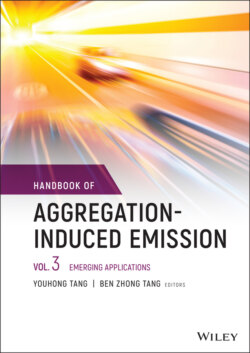Читать книгу Handbook of Aggregation-Induced Emission, Volume 3 - Группа авторов - Страница 38
3.1 Introduction
ОглавлениеLuminescence was first used as an analytical tool for the determination of various species and chemicals. For example, sensing based on fluorescence is one of the most effective methods for the detection of analytes since specially designed emitting probes allow high sensitivity and selectivity [1–12]. Notably, materials that react with external solicitations (physical or chemical) through modifications in their fluorescence are today defined as chromogenic or fluorogenic. This feature has evoked a growing interest in the last decades for the development of plastic sensors, thanks to the progress of fluorogenic molecules whose optical features and chemical functionalities allow their effective utilization when embedded in many thermoplastic and thermoset polymeric matrices [7, 13–17]. Among the different types of fluorogenic probes able to response to external stimuli, those with aggregation‐induced emission (AIE) property (i.e. AIE luminogens (AIEgens)) have attracted tremendous interest since they were proposed in 2001 by Ben Zhong Tang [18]. The AIE effect arises from the restriction of fluorophore intramolecular motion (RIM) that is typical of those molecules whose structure consists of two or more units that can dynamically rotate against each other [19]. Moreover, the presence of a twisted propeller‐shaped conformation renders intermolecular π–π interactions difficult in the aggregate state, thus minimizing quenching of the emission in the solid state. AIE fluorescent sensors take advantages from the very brilliant emission in the solid state that allows for the development of efficient ON–OFF and, more interestingly, OFF–ON optical response toward several interferences.
Noteworthy, by allowing light emission in the aggregate and solid states, AIE fluorophores (AIEgens) have striking impacts on energy, optoelectronics, life science, and environment as revealed by the increasing number of patents and publications since 2001. Most of the documents are in the area of chemistry (33%), material science (22%), and chemical engineering (15%) [20–22].
In connection with these findings, polymer films and polymers, in general, are perfect candidates to evidence the importance of AIEgen fluorophores with respect to the traditional ones [23–28]. Thermoplastic, thermoset, and elastomers have been extensively utilized as continuous matrices for the effective incorporation of dyes, pigments, and fluorophores aimed at preparing colored materials following experimental procedures well known since the early time of plastic era. Incorporating a moderate amount of (<5 wt.%) fluorophores does not produce any structural alteration in the polymer matrix. Therefore, the polymer can still form flexible, moldable, and durable films with different shapes and thicknesses. Nevertheless, commodity plastic is often made by saturated macromolecular chains that are scarcely able to promote effective secondary interactions with the physically dispersed or covalently linked chromophoric aromatic units (Figure 3.1) [16, 29, 30].
Figure 3.1 Strategies for obtaining AIE‐doped polymer films by means of (a) a physical dispersion approach or (b) a covalent‐bonding approach.
This is reflected in the formation of clusters or aggregates of the dye or fluorophore molecules, whose size is often governed by their final content. It is actually well reported that the aggregation of aromatic planar fluorophores that occurs in the solid and condensed states suffers from emission quenching phenomena known as aggregation‐caused quenching (ACQ) [31], which strongly limits the number of accessible fluorophores for practical and effective applications in plastic materials and devices.
Conversely, the intense fluorescence emission provided by the AIEgen dopants even at the highest doping content allows for the design of highly emissive plastic items, films, and devices. This characteristic enables the development of high‐performance polymers for many applications, including those in the area of chromogenic smart materials and in the energy field [23, 27, 32–40]. The application of fluorescence therefore appears unlimited, and this feature is a continuous stimulus for the scientific communities in providing novel, innovative, and intriguing outcomes. The most popular AIE polymers with outstanding characteristics and applications have been recently reviewed. Briefly, polyacrylates, polystyrene (PS), polyethylene oxide, poly(ε‐caprolactone) (PCL), and polysiloxane based polymers have been the most investigated [23, 27, 33, 41].
In this chapter contribution, after a brief introduction about the working mechanism at the base of the AIE process, the use of AIEgens is described as excellent fluorescent dopants for polymer films for applications in the fields of optical sensors toward external solicitation and as plastic solar collectors. As far as the sensing application is concerned, external contaminations such as mechanical solicitations, thermal stress, and the exposure toward volatile organic compounds (VOCs) are taken into account. Examples of AIE‐doped polymer films obtained from the physical dispersion and the covalent approach are proposed and examined with regard to the final performances. Concerning the energy topic, apart from organic light‐emitting diodes (OLEDs) and organic solar cells (organic photovoltaics, OPVs), bright AIE emitters in solid state with good photostability have been used as solar harvesters in polymeric luminescent solar concentrators (LSCs), thus enabling the diffusion of photovoltaics (PVs) in the urban environment. Illustrative examples in this topic are also provided. The case studies reported in this chapter come from the work performed in the author laboratory, with complementary additional examples selected from the relevant literature.
